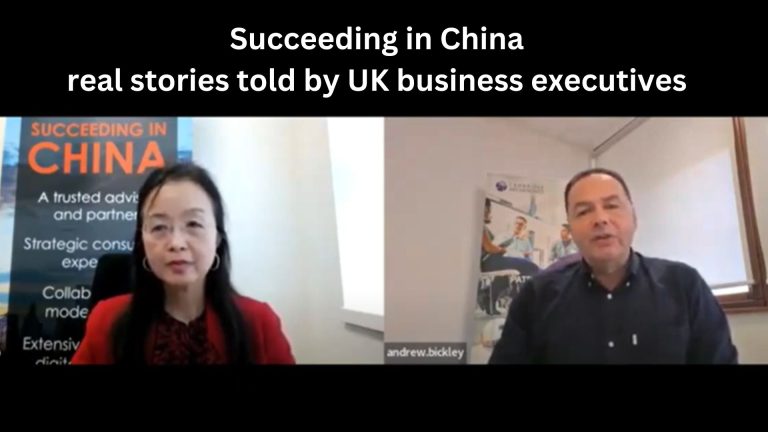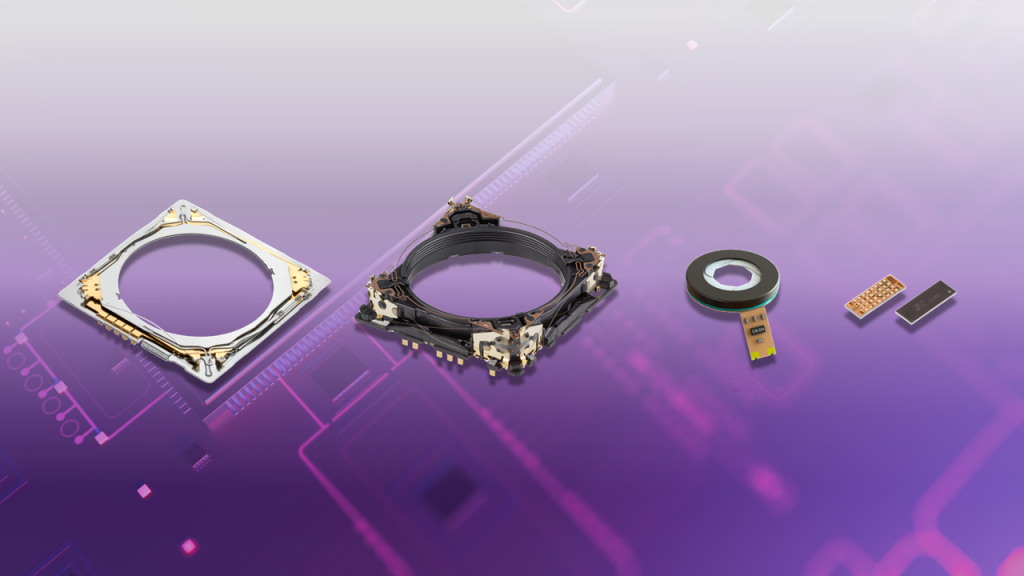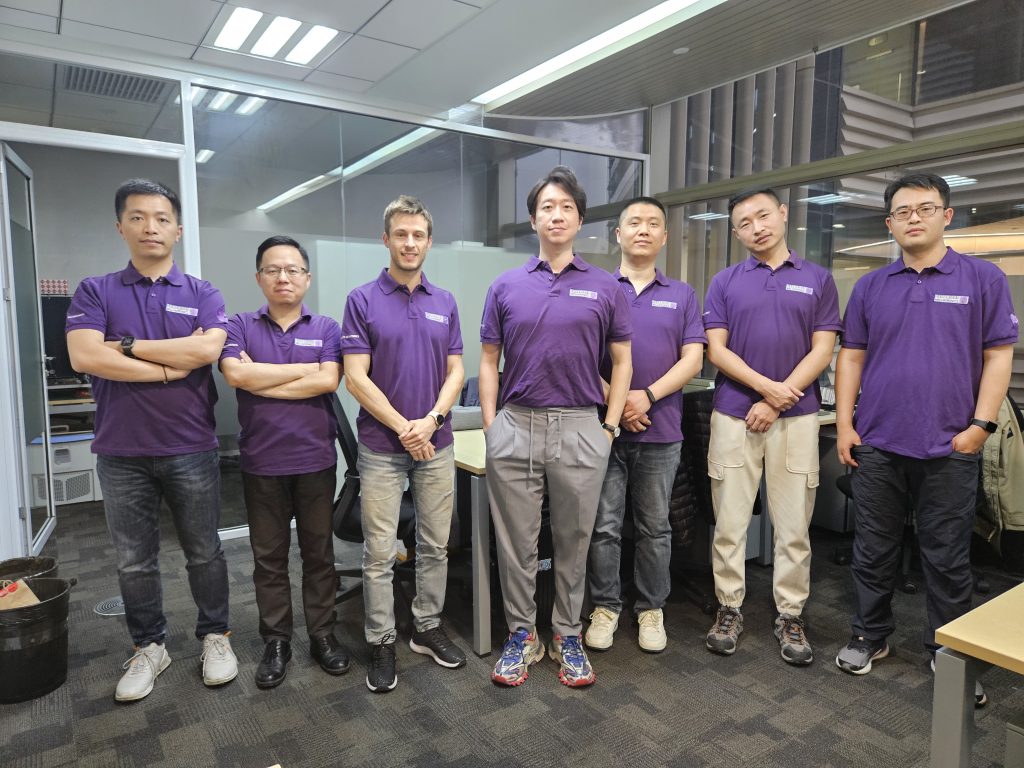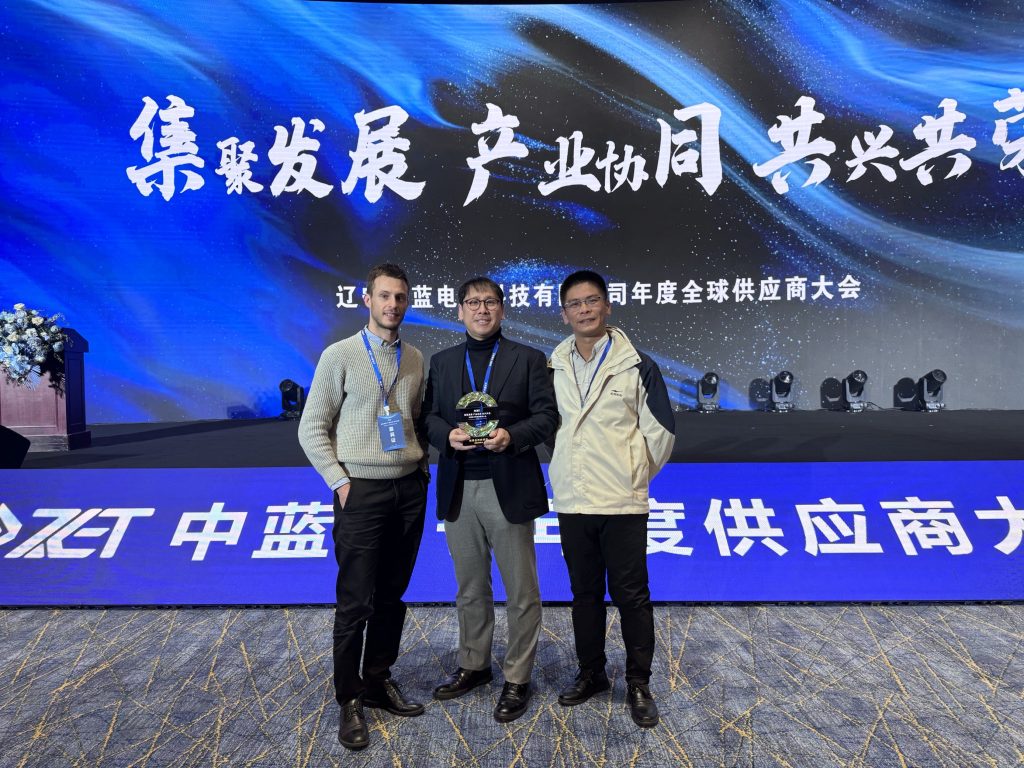Succeeding in China - real stories told by UK business executives

What does it take for UK technology companies to succeed in China? Ting Zhang, Crayfish.io Founder and CEO has been putting this question to some UK business executives on camera.
The ‘Succeeding in China – Conversation with Ting Zhang’ video interview series aims to share some insights, reflections and practical advice through real stories of UK technology companies that have managed to enter and expand in China successfully.
In the first of the series, Andrew Bickley, co-managing Director of Cambridge Mechatronics (known as CML), a world leader in compact SMA actuator and control solutions, shares his company’s China success story, the learnings, and reflections on the challenges along the way in the past 10 years.
The Cambridge-based high-tech company has some extraordinary numbers to show, from a humble start of one product launch to 700 patents and the latest round of funding of $40 million in 2024, its China operation grew from one licensee to 5 in 10 years and can count Huawei and Xiaomi as its main customers, supported by its two offices, Shenzhen and Shanghai.
CML SMA technology is used to control and position objects with the highest level of precision, such as in mobile phone cameras, haptics, 3D sensing and new applications like AR. SMA stands for shape memory alloy.
China has been one of CML’s key overseas markets since it first set foot there, 40 of its 45 products are for Chinese customers. Its business in China has grown steadily against the backdrop of a fast-changing market landscape and the wider global business environment. The scaling goes on, and CML sees its China business double in value in 3-5 years.
A fascinating story. So how did it start? What are the main learnings, the strategic element and the art of succeeding in China?
• The journey, top competitive advantage, and company’s core DNA
Ting: So, how did it start?
We started as early as 2013 and our technology is called optical image stabilisation, which is appropriate for smartphone cameras. In 2013, we were working with an American company to produce actuators to enable this technology. Then, optical image stabilisation started to become very important in the Chinese market and there was, around 2015, a lot of interest from Chinese companies to use what we call OIS optical image stabilisation.
We had our first license in China in 2017 and that was with TDK. And then we started to see a lot of interest from Huawei who really grasped the advantages of this technology and they started to work with us exclusively on a particular product series of SMA and we were very successful with Huawei introducing it into the P30 Pro and the Mate 30 Pro products. Since then, Huawei has been able to innovate with this technology so we’ve been a regular part of their camera solutions.
Then, building on that, we started to expand our presence in China, where we have five manufacturing licensees who create optical image stabilisation as actuators, which can be delivered into smartphones.
We then progressed through 2021 and 2023 to design controller ICs, because although we were providing the actuator technology we were relying on third parties to provide the controller. So we started to develop the controller IC, and we can now provide controller ICs as part of the total solution.
But the big benefit for our customers where we have progressed from 2013 to where we are now is that we can provide a complete solution of the actuator, the control algorithm, and the semiconductor product to host it.
Ting: So is your total solution also your biggest competitive advantage over your competitors?
Absolutely. One of the crown jewels that we are experts in is the algorithm development. So how do you control the wire? How do you control the wire accurately? You know, how do you control the wire with the lowest power and resistance measurements? We have control algorithms which are patented. And protected, so that our competitors can’t do it.
So our biggest advantage is we are experts in the mechanical design of actuators. We are experts and have patented technology for the control algorithm and that algorithm is now hosted on an optimized controller IC that we provided to the total system solution.
Ting: Yes, I understand that you have 700 patents granted and pending. So that is very much a competitive advantage over the other players in an industry.
Absolutely. As you know, we’re a Cambridge-based company, so a lot of our engineers are PhD based. A lot of our engineers come from Cambridge universities and they’re very dedicated to innovation and filing patterns and coming up with new ideas.
So that’s the core DNA of our company is the heritage of innovation and the patterns that we are able to generate.

• Key learning points: tech transfer, fast and agile, being truly local, and staying ahead…
Ting: CML has come a long way in China over the past 10 years. Looking back, what are your key learning points?
There have been many. The first one is a faster transfer of engineering support and engineering functions to China. A lot of companies will try to remain operational in China through their core competence in a Western country. We have learned many things about working in China and being successful in China.
One of the biggest things is to transfer faster engineering technology and processes to China to be truly local. Western companies will have a preference to keep that at the headquarters and not relinquish it to be closer to the customer. So that’s one of the big learnings.
The other one is tools. Chinese customers want to be self-serving. They want to do as much as they can and be autonomous. So you need to create tools to allow them to do that. And then the other simple learning point, but is sometimes difficult and it’s where you’ve been helping us is scaling up teams, scaling up teams to get the right talent. To get the right type of person who can operate locally in China but also can interface with a Western company and understand sometimes the drawbacks of working with a Western company.
Ting: So essentially you are enabling your Chinese customers to improve their design capabilities and catch up on their Western counterparts as well, right?
Yeah, but you know, China is rapidly aggressively catching up, and in many cases is leading. If you take Huawei for example, they are one of the best innovators of mobile phones in the world. So that gap between China and Western companies is closing very rapidly and we see a difference even over two to three years. So the gap is closing. Obviously the thing with Chinese companies, they’re very fast, right? They’re very fast. They’re agile. And so you know companies like ourselves are having to keep up and we’re learning a lot by introducing Agile and do-it-right-now processes into our company.
Ting: And you’re still keeping a good distance from the local competitors, right? So you are always ahead.
Yeah, because of our heritage, and our innovation, we will always be ahead of local competition and we will always have our advantages protected with patents. So we will always maintain that advantage. But, you know, what’s really important for China is those advantages need to be transferred into products as fast as possible and that’s where we have the innovation and then China is accelerating that innovation through to a product solution.
But we will always have a gap between ourselves and the competition because we are the world’s experts in SMA technology and the control and silicon products for those solutions.

• East-West gap, the magic of HQ-local dynamics, and the art of listening
Ting: Even with such an advantage, having a local talent team will further help you compete in a fast-evolving Chinese market. Right? As you know, customers in China want things that happened yesterday.
Absolutely. So we originally started in China on a consultancy basis with a customer support team. We very rapidly moved them to CML employed personnel and you know we’re expanding even now, but you need the local people. Because sometimes we’re getting requests which are very demanding, very fast. Our local talent will explain to us and get us to understand why we need to respond in a certain way because this is the way the Chinese market works.
This is the way innovation works in China. Western companies can get a little bit caught up in the process, right, the process of let’s do this with thorough documentation, whereas Chinese companies want it done right now. I think our local teams bridge the gap, between doing it right now and the Western companies that want to take a different approach.
Ting: And having that very good interaction between your HQ from senior management such as yourself, but also your technical team, the constant communication between the headquarters and your Chinese team is very important, right?
It is. The magic is when you have a talented Chinese local organisation and, in our case, the UK innovation organization which understands the dynamics and the way of working in a Chinese market. If you try to impose Western ways of working into the Chinese market, you will fail, right? This is one of the biggest learnings. Our local organisation and our local talent are keeping us educated in terms of what success means for our Chinese customers and how we have to support that.
So in terms of lessons learned, talent, local organization, listening to them and following their recommendations. It may sound simple but it’s so strategic in being successful in China.
Ting: Yes. I remember we helped CML when you started setting up the wholly-owned subsidiary just before COVID-19 started. We were able to actually get it set up during COVID which was very helpful for you to maintain this growth all the way throughout the COVID time.
We really appreciate the support that you’ve given to us and we’re on a growth curve. You know we are expanding in China, we’re moving more processes and design support to China. So we will be increasing our footprint in China and you definitely helped us get a head start on that process. So thank you again for that.
Ting: You’re very much welcome. it’s our pleasure to be able to help CML through its growth period and further expansion.
• Success factors, roadmaps, innovations, sustained growth, and Huawei
CML has shipped over 70 million devices in the past four years. And the product launch, my understanding has gone up from one a few years ago, six years, to 45 products with 40 out of the 45 products being for Chinese customers. China has been CML’s focused market. The majority of CML’s licensees, such as TDK, ZET, and Galaxy, are Chinese as they all have manufacturing in China. Huawei Honor, and Xiaomi are among the well-known Chinese brands that have adopted CML SMA technology. Fascinating growth throughout the pandemic.
Ting: So what is your secret to staying in such high growth? I mean what are the key Success Factors behind each major win? For example, with Huawei or other customers, how did you manage to stay as a long-term vendor /supplier /partner and also keep growing that relationship, growing that sales?
Yeah. So Huawei is a good example. So as we said earlier, Huawei is a highly innovative company with fantastic engineers. They’re also very demanding. They produce the best products because they are demanding and they drive for success. So part of our success is being very well aligned with Huawei in terms of their roadmaps, their requirements, and their vision for what needs to happen in the camera application in the next two to three to five years forward. And then we need to be able to demonstrate to Huawei that they’re with the right partner and that we are capable of giving them the solutions that they need in three to five years.
So what you’ve got to do is tune your roadmaps and your technology into a lead customer like Huawei. And you’ve got to be prepared to have dedicated teams which understand how to work with demanding customers who are driving for the best possible products. You’ve got to ring-fence those resources and have them dedicated to people like Huawei so that they learn from Project One, and then they go on to Project 2, and Project 3. And we take all of those learnings to become a highly efficient design partner with Huawei.
So the biggest Success Factor is, we have to stay ahead of the curve on innovation. We have to stay ahead of our competition, but we have to listen to Huawei and tune our roadmaps to the requirements that they see, going forward, they are going to be demanding, and keeping up with them. Keeping up with this demand is one of the key Success Factors. If you keep up with their demand, if you deliver the right products, if you have the right innovation, you will have a long-term relationship with Huawei. If you’re not able to do that, it’ll be a different story.
Ting: And of course, they had this huge popular launch of the Mate 60s last year (2023), which used your technology and assuming that that was also a big success in terms of the sales orders.
Yeah, the Mate 60 was a fantastic phone. So congratulations to Huawei. It was a real success. And of course, this is a great example of success in China. If we have the right products, we get into the right phones. If the phone is designed correctly, it wins in the market and then the volumes follow and the Mate 60 volumes were fantastic. So that was a really good example where we were able to meet Huawei’s requirements and enjoy the growth revenues that that phone delivered.
• Locations, rapid response, culture, mentality, local knowledge and WeChat
Ting: CML has two sites in China, Shenzhen and Shanghai. To other Western tech companies, would you recommend setting up sites in multiple locations for different purposes when they go to China?
I definitely would because if you’re supporting your customers regularly there, you’re visiting them regularly every week. Also, there is the on-demand that you need to react to. So if we have partners or customers in Shanghai who call us up in the morning and explain an issue, we want to be with them, you know, within an hour. So I think you need to select carefully. I think you have to have multi-site facilities across China. China is so big so you need to choose carefully.
And I think the guidance I would give to anybody is you need to be close to your customers and you need to put the design support and resources very close to your customers. Now being able to be on-site with customers within an hour or an hour and a half if a critical problem comes up, it’s really important.
Ting: From your various trips and your business dealings with your Chinese customers or counterparts or partners and staff, do you have any advice on cultural aspects or reflections as a Westerner?
Yeah. I would say if you’re a Western company and you’re and you’re trying to operate in China, the first thing is to leave the Western mentality behind. You have to have a completely open mind. There are going to be approaches and ways of working, communication styles, and meeting environments which are totally new and different. You need to embrace that and absorb it, but you must be complemented by your local team who will navigate you through some of these things.
There are many meetings that I’ve been into that I’ve come out a little bit confused, and my local team has been able to explain to me what actually had happened, what had been communicated, and what it meant.
So my biggest tip is to embrace the culture. Please don’t bring a mentality of the Western way of working will work and use your local team and be open-minded with your local team to be guided on the meetings and the communication and the style of doing business in China.
Ting: Yes. Also, I noticed CML has its own WeChat channel, a digital marketing channel. So it helps to educate your customers and engineers, but also gives the vehicle for your staff, and your team to share with their friends and colleagues to share the success story.
Yeah. A lot of our engineers are on WeChat with the engineers of our customers. That’s a great media platform for us to stay engaged in a rapid way with our customers.
Ting: In China, it’s almost like paperless now. So our top business travel advice is to get WeChat. Are you on WeChat?
I am. The only thing I haven’t set up on WeChat is to be able to pay in China. I have been going out to dinner with my general manager and I tried to pay with my credit card only to find out that it’s only WeChat.
• Major obstacles - IP, Competition, China pace, geopolitics, , diversification, and pandemic
Ting: So now you have of course achieved a lot of success in China, but what have been those major obstacles that you have overcome? And, thinking back, were there any pitfalls that would have been, fatal if it wasn’t avoided?
Yeah. Some of these obstacles will not be a surprise. The first one is IP protection. If we’re going to be operational and supporting customers in China, we need to make sure that we have our IP protected and that’s for the benefit of our customers and our supply chain partners. So I think an extra effort around IP protection for China is always an obstacle that you need to address.
I think the other one we touched on a little earlier is competition. Local competition develops much faster in China than it does in Western countries. That means if you’re developing a product portfolio for China, you have to be super fast because Chinese local competitors make advances quite rapidly. So staying ahead of the game on road maps and product development and innovation, that’s really important and it’s a different pace in China.
The other one is the geopolitical landscape where we need to tune into that and be sensitive to that. But what does that mean? It means you need to have local Chinese supply chains so that you’re not influenced by maybe, you know, restrictions or other things that are going to come up around the geopolitical landscape.
Lastly, the one that I think was common to everybody and hopefully it doesn’t happen again was COVID. Right in the middle of our key growth time was COVID. So we had to manage our workforce. Our customers were continuing to design so we had to support them. Normally we’re very hands-on when customers are bringing up phones, we’re hands-on in the factory. That was difficult. So we did a lot of remote work to get over the COVID period, but hopefully, that was just a one-off.
Ting: About challenges, geopolitics was a challenge and remains so. You mentioned the supply chain, which is mainly about supply in China, that’s for the Chinese side. What about the UK side or the Western side? Any geopolitical implications?
No. I think the main one is to operate in China. It’s very clear in every meeting that what Chinese customers want to talk about is local supply. And we’re very accommodating. We’re trying to enable that in the bill of materials. We’re trying to enable that in the supply chains. Our controller ICs that we sell in China are all manufactured and assembled in China. So when you start the development of a product, you naturally start it by looking at ‘How can I get this manufactured in China as opposed to getting it manufactured in other areas of the globe?’
Ting: Do you have any concerns or reservations about the fact that most of your business comes from China when it comes to presenting the company to investors or PR, in a wider sense?
No.Because we’re diversifying our business. The China smartphone market is very important. It’s been our first market but we have other markets that we are pursuing, too. We have the medical market which is global. Actuators and precision actuation and control, our ICs apply to that market. That will take us into markets outside of China. We have been operating in the AR and VR market, which is predominantly outside of China right now.
So in terms of when we were going through the investment rounds, the diversification of our business was an important point, but so too is the potential of the technology that we have. Our technology can go into multiple applications. It’s just that we’ve been very successful in the Chinese market and we will be successful in markets outside of China as well.

• Going forward… deepen localisation, double business, more hiring, agile and rounded operation, stay ahead
CML is hiring more local talents for China operations. This is part of its strategic move towards deepening localisation in manufacturing and product design. It’s also developing a more agile and rounded operation to stay ahead of the competition on key fronts.
Ting: Looking ahead, what is your ambition? What would your business in China be like in three to five years?
Yeah, China is an incredibly important market to us and what we want to grow. We want to sell more of our system solutions in China. Our controller IC platform and our silicon platform are very important. We will be having multiple products which will give benefits to our customers. They will be higher performance. They will be lower power. Of course, they have to address costs. So there will be lower costs. There will be better tools, and there will be better service.
We will expand in China and we would expect over the next three years our business would easily double, in value, in China. We see a good future in China. What it means for us is we are investing that $40 million that we have is investing in our core semiconductor capabilities and it’s also investing in some efficiencies and tools that will give our customers the best possible experience when they engage with CML.
Ting: So we’ll see a lot more talent needs to be recruited in China if you’re looking to double the business.
Absolutely. And you know, getting the right talent is not easy, particularly if you’re a Western company. I mean you need the local management and infrastructure and knowledge base to be able to recruit correctly. So we’re well established in China now, but we will grow and we will be expanding the team.
Crayfish.io is a trusted advisor and partner dedicated to helping UK businesses to succeed in China. We provide comprehensive UK-China business services in strategic consultancy, IP protection and commercialisation, and a digital platform. CML is one of our valued clients. CTA
CML is a world leader in compact SMA actuator and control solutions. SMA stands for shape memory alloy. The CML SMA technology is used to control and position objects with the highest level of precision, such as in mobile phone cameras, haptics, 3D sensing and new applications like AR.
Both companies are based in Cambridge, UK.












